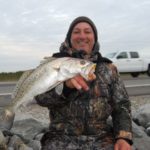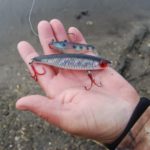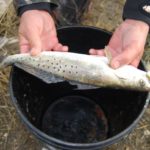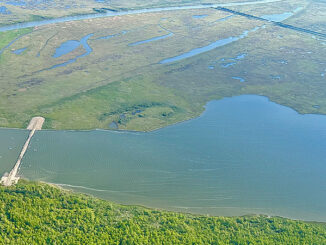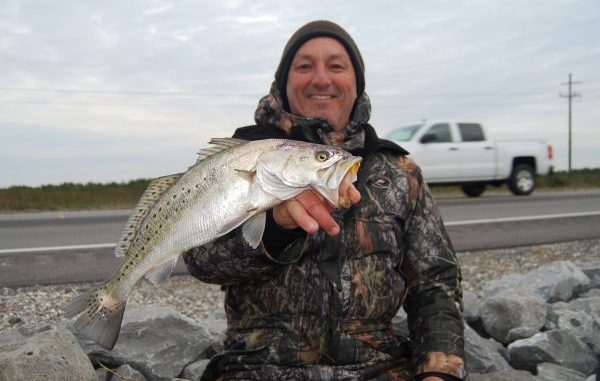
Vidrine suggests hot baits for roadside trout, redfish bite
As Tommy Vidrine’s Chevy pickup crested the bridge over Caminada Pass heading west from Grand Isle, the lights of Port Fourchon shimmered in the distance.
His digital clock blinked 5:44 a.m., but I was more focused on the dash thermometer, which read 43 degrees.
That chilly temperature, combined with a wicked north wind howling steadily at about 20 mph, would make for an interesting morning of wintertime roadside fishing for speckled trout and redfish along state Highway 1.
“I call this ‘park and fish,’” Vidrine said with a laugh as he pulled over to a pond in the darkness a few minutes later, his headlights capturing roadside grass whipsawing in the wind. “It’s very easy, and it’s different from being on a boat. There’s no work, no effort, no gas and it’s cheap.
“Anybody can do it.”
And despite the non-stop wind, bitter cold and tough conditions, Vidrine, who was outfitted more like a duck hunter than a fisherman, made it look easy.
In complete darkness, well before the first hints of sunlight cracked the horizon, he caught three specks by casting his swimbait into the deepest part of a pond south of the highway, letting it sink and then working it back with a slow, halting retrieve.
The 51-year-old Grand Isle trout aficionado, who resides in Baton Rouge and works as an independent contractor for Aflac, said he likes to fish early in the mornings, even when the weather is frigid.
“People would think the fish are going to bite when the sun comes up and it gets warmer, but it’s weird. It’s just like the summer,” he said. “You can catch them sometimes at 12 or 1, but the bigger fish – the 3-, 4- and 5-pounders – are caught at daybreak to about 8:30.
“After that it’s work. It’s not catching anymore, it’s fishing.”
Vidrine says the roadside trout bite usually picks up around Thanksgiving, depending on how many cold fronts have pushed through by then. Action can continue into March, he said.
“These holes on the side of the road are like a sanctuary for trout,” he said. “If it gets real warm and the bait goes out, they’ll follow the bait. But when it gets real cold, the bait comes in and the trout stay in there, and when we fish with our swimbaits or twitchbaits or topwaters or whatever we try to entice them with, they’re going to eat. They’ve got to eat.”
Deeper holes, about 10 feet, provide the warmer water temperatures trout seek during the winter, and that’s where Vidrine focused on throwing his lure from the bank and keeping it in the strike zone.
“That water at the bottom of the 10-foot hole might be 55 degrees,” he said. “The water at the top might be 35 degrees, so guess where they’re going to be. They’re going to find the warmest water they can find with some bait in it.”
And knowing what the fish are feeding on – and using the right lure to replicate that – is a big component of roadside success.
“You have to try to match up whatever the environment is providing for those fish to eat with what you’re casting,” he said. “If it’s a Vudu shrimp under a cork like it was two months ago, there was shrimp in the marsh and in those ponds. But once all the shrimp moved to the Gulf, the trout started eating finger mullet, so we switched to the twitchbait and the swimbait.
“You have to transition when they change their feeding habits and imitate what they’re eating.”
Vidrine is a big fan of the lightest, skinniest 2 1/2- or 3-inch Tsunami swimbait available, and the redfish like it, too.
“When it gets cold like this, let it sink and twitch it light. It looks so real, just like real bait,” he said. “It’s like magic compared to any other bait.”
His other go-to rig for mid-winter specks is MirrOlure’s Catch 2000 suspending twitchbait, with a black back and white underbelly. Vidrine uses 12-pound mono line exclusively when roadside fishing.
“Most of the time I like to let it sink about three seconds after I cast, then I like to twitch it with a downward motion to keep it low,” Vidrine said. “I like to give it some good, hard twitches.
“Sometimes they want it faster and sometimes they just want a straight retrieve. Try different ways until it works, then duplicate it again.”
When selecting a roadside fishing spot right now, a couple of keys to look for are the presence of baitfish and cormorants, Vidrine said.
“Look and see if there are mullet flipping, and most of the time you’ll see cormorants diving down,” he said. “If the bait is in there, the cormorants are in they’re diving and eating.
“When you see that, the bait is there, and if the bait’s there, trout or redfish will be in there, too.”
Be aware, however, that some areas are private property along Highway 1, even if there are no signs.
“Most of it is public, but there are a few places where they might kick you off,” Vidrine said. “But the bridges all the way from Grand Isle to Fourchon are good for redfish. You can put some dead shrimp on a jighead and throw it on the bottom and catch redfish almost all the time, anywhere.”
And just like he recommends at the height of the summer trout bite, Vidrine said to be prepared to stay mobile to catch more fish in the winter.
“In the wintertime, you’ve got to stick and move,” he said. “It’s just like when you’re in your boat, but now you’re in a car. Park and fish, try a little bit and then move to another spot.
“Once you do it a lot, over the years, you learn the spots so you can move with the conditions.”
And either side of the road can hold abundant fish, he said.
“If it’s a south wind, you want to fish the north side of the highway,” Vidrine said. “If it’s a north wind, you want to fish the south side of the highway. The road blocks the wind and keeps the water clean. Those trout eat by vision, and if the water is muddy, they might move to a clearer spot.”
The trick to catching more fish is to slow down your presentation as much as possible, especially in very cold conditions.
“If you’re fishing with plastics, you have to slow down and almost stop sometimes,” he said. “If you feel a little bite, leave that bait there for as long as you can without retrieving it because you’re in the strike zone longer. If you felt a hit, there’s more there. If that fish missed it, another one might eat it.”
And when you do get a bite, you might have to wait to set the hook, he said.
“That’s hard stuff to do for most anglers – when they feel pressure, they want to pull,” Vidrine said. “But in the winter, when it’s cold, you have to wait. Those trout are lethargic because of the cold water, and might not have the whole bait in their mouth.
“Sometimes you have to wait three, four or five seconds to set the hook in the winter. It’s crazy.”
